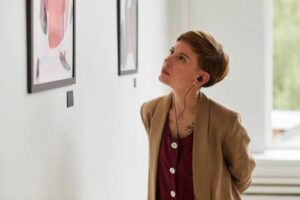Finding the Right Tour Audio System For Your Sound Environment

Background noise on your tour is likely robbing you of your visitors’ full attention. This is due to the way our brains process sound. The brain has a system called Selective Auditory Attention that helps people focus on a specific source of sound. For example, when you enter a loud environment, like a cocktail party, your brain processes all of the sounds simultaneously, but when you strike up a conversation with a friend, your brain prioritizes the information coming from your friend’s mouth. Now the once loud cocktail party is a muted roar in the background and your conversation takes complete priority.
Unfortunately, our minds have limitations. At some point, the background noise gets so loud that you’re left trying to read lips. Your attention and understanding quickly devolves as your focus drifts elsewhere or you mishear parts of the conversation. This can be debilitating for people with hearing impairments.
A guided tour is no different. If the background noise gets too loud, participants will be unable to focus on the tour guide’s voice. They may lose interest and stop paying attention or misunderstand your message.
Loss of attention or poor message clarity has serious brand implications not to mention safety concerns. It can cause lost sales, bad reputations, and injuries. No matter your tour situation, losing clarity of message is not something you want to risk.
Enhanced Hearing Solution
Luckily the solution to the brain’s innate limitations is fairly straightforward. Instead of hoping that guests will be able to hear over the background noise simply use a tour audio system that’s right for the sound environment.
Two-way tour guide systems both transmit and receive audio and provide clear hearing in any sound environment. Whether you’re in a noisy plant, an outdoor arena, or a museum, tour guides need to be able to communicate with participants and field questions without having to raise their voice or repeat themselves.
The presenter communicates using a hands-free headset with a microphone and the transceiver is worn on a lanyard around their neck. Participants wear the transceiver on a lanyard and wear a headset or earphone enhanced hearing. If a participant has a question or comment, they simply push the button and speak into the unit’s microphone.
Best Tour Guide System for Sound Environment
Different environments have different audio needs. We’ve detailed the most common sound environments and solutions for each below.
Loud Sound Environments
Noisy tour environments with a lot of loud background sound require a headset that blocks out the ambient noise so the listener can effectively hear the conversation and important information. Tour environments with loud sound include:
- Factories
- Food Processing Plants
- Packaging Plants
- Sanitation and Water Plants
- Bottling Plants
- Automotive Plants
- Manufacturing Plants
For the best possible experience, you’ll want a headset with an adjustable unidirectional noise-canceling boom microphone. This allows you to adjust the mic as close to the speaker’s mouth as possible and cut out background noise that otherwise would come through, making it easier for your guests to hear. For the ultimate sound experience, you’ll want to combine the boom mic with a headset featuring dual over-the-ear speakers.
Medium Sound Environments
In medium sound environments headsets that sit on-the-ear versus over-the-ear are preferable because there is less ambient noise, but participants still require some isolation from the environment. The headset should include a unidirectional boom microphone to pick up the voice of the person speaking. Medium sound tour environments include:
- Assembly Plant
- Outdoor arena
- Boat Tour
- Tour Bus
- Rail Tour
- Walking Tour
For tours in these environments, a headset with single or dual on-the-ear ear speaker with a boom mic will give the group a good communication experience.
Quiet Sound Environment
 Audio systems in quiet environments can use a variety of different headsets because of the reduced ambient noise. Examples of quiet, low sound environments are:
Audio systems in quiet environments can use a variety of different headsets because of the reduced ambient noise. Examples of quiet, low sound environments are:
- Conference Room
- House of Worship
- Museum
- Classroom
- Courtroom
In these environments you’ll want to focus more on a headset that’s comfortable, has good audio quality, appropriate ear speaker(s), and microphone placement. You should also consider using neck loops to support people with hearing aids.
The Result of Using the Right Tour Audio System
With the right two-way audio system, your message isn’t left to chance and your visitors are better able to engage with your brand, your guide, and the information you’re providing. All of your guests will be able to clearly hear your message (including people with hearing problems) and you won’t be risking your brand message or their safety.
You might even be surprised with the immediate feedback you get from customers. Case Systems recently got the following feedback after switching to a system provided by Tripp Communications:
“I learned so much on this tour! I’ve been on four of your plant tours over the years and this was the first time I’ve been able to hear anything!”
If you have any additional questions about picking the right tour we’d love to walk you through the process of selecting the right system for your sound environment. Contact us for a free consultation.
